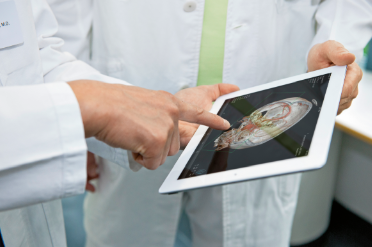We’re a mobility-based world these days, so what’s keeping the iPad out of the ER or the OR or from being used by radiologists and physicians consulting on the same case from different parts of the planet? Absolutely nothing, it turns out, thanks to Siemens Healthcare’s WebView and WebReport mobile applications.
We’re a mobility-based world these days, so what’s keeping the iPad out of the ER or the OR or from being used by radiologists and physicians consulting on the same case from different parts of the planet? Absolutely nothing, it turns out, thanks to Siemens Healthcare’s WebView and WebReport mobile applications.
Over at the Siemens booth at RSNA 2012, I watched in amazement as Marc Lauterbach used Siemens’ syngo.via advanced visualization software to conjure up detailed 3-D images. “The motto is: Get the full picture,” said Lauterbach. “So it’s not just yes or no there’s a tumor, but providing quantitative information out of the image such as size, type, the exact location — almost like an anatomical GPS.”

Photo: Siemens
We looked at an image of a ribcage that looked more like a tree with the ribs numbered, so lesions would be very easy to identify, in contrast to the old-school cross-section images. “We get a full picture in a fraction of the usual time,” said Lauterbach. “We help the radiologist focus on what’s important.”
The two mobile applications are syngo.via WebViewer and WebReport. WebViewer is for fast reading and viewing of images within the hospital network. This is especially true in larger hospital settings where examination rooms, reading rooms, treatment rooms, and patients are all located in different parts of the hospital campus. Connection is possible from anywhere within the reach of the hospital network through a secure VPN connection. It eliminates the need to bring stationary patients back into an office to explain the diagnosis or the future treatment plan. Even 3-D images can be used to explain the diagnosis where the patient is located.
WebReport is best when secure viewing of reports and images by cross-departmental physicians and referring physicians is in focus. Case clarification within multiple location hospitals and with referring physicians outside the hospital becomes easier than ever. Through mandated access, physicians are granted access to their patients’ records only while keeping all other sensitive patient data secure. Access to relevant patient data helps minimize the risk of errors in the future course of treatment. Since WebReport can be accessed from a standard Web browser or on an Apple mobile device, sharing information with fellow physicians inside and outside the hospital is fast and easy. Patient data is not stored on any external PC or device – all data remains securely within the hospital.
Marc called up images on an iPad and maneuvered them with fingertips — exactly the way you would with your family snapshots. Scrolling, pinching, enlarging and working with images in 3-D of human anatomy — so-called VRT or “volume rendered” images. This could be used by a radiologist on the go, logging on from an airport for example, or it could be used by physicians who want to consult with colleagues in other locations. And the images are stunning.
With a colleague on a second iPad, Marc demonstrated how a radiologist could seek a second opinon, sending a link to the patient images to another physician and being able to jointly manipulate and examine the images.
“One of the really nice things about this setup is that it’s easy to understand, easy to learn,” said Lauterbach. “Anyone can learn it in a fraction of the time it would take to go deeper into other applications.”
Somewhere Steve Jobs is smiling.